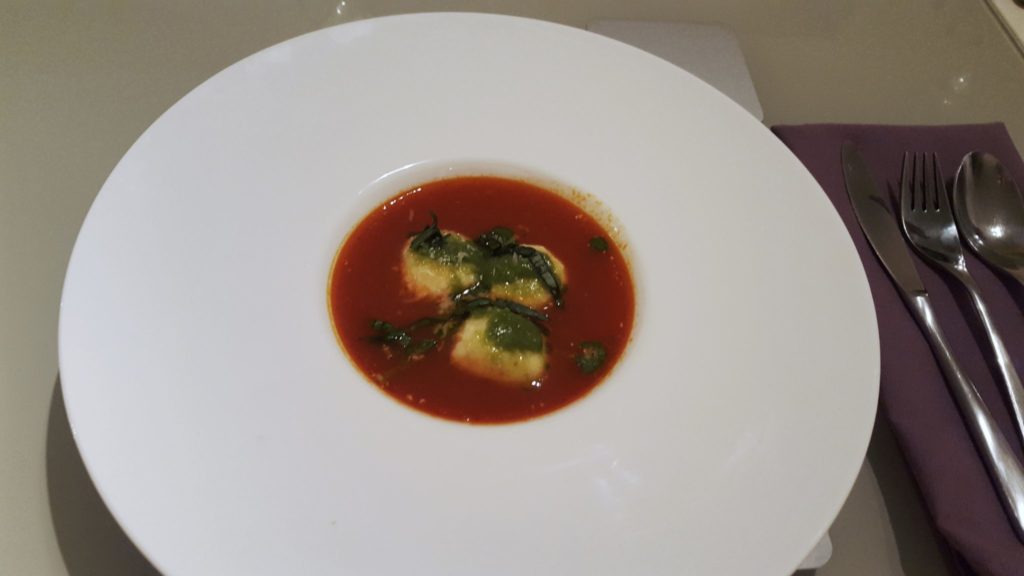The first and last time I made potato gnocchi was at my dinner party from hell. Everything that could go wrong did go wrong. I knew it didn’t bode well when I found myself covered in flour, rolling out pastry for the poached pear dessert gone 8 pm, with my guests awaiting the merest hint of food over a glass too many.
How right I was.
When I retrieved the home-made potato gnocchi from the fridge, they were green! Maybe they would have still tasted OK once cooked, but I didn’t feel confident enough to reduce my guests to guinea pigs. Into the bin they went.
Next I retrieved my 6 partridges from the oven. Or so I thought. Number 6 had mysteriously flown off. One of my guests was not very well, so, living in hope, I casually asked “you sure you’re up to a partridge, Helen? I can do something lighter for you if you prefer?” “O no”, she said, “I’d definitely like to try the partridge”. Wrong answer.
I don’t recall exactly what I DID manage to serve that evening, but it’s one of those nights I’d rather not care to remember. I never did find that missing partridge. And two of my guests never came back for more.
 Suffice to say I remain a little nervous in the company of gnocchi. Ricotta gnocchi are more forgiving, but this time I felt compelled to attempt its cousin, the ricotta gnudi, instead.
Suffice to say I remain a little nervous in the company of gnocchi. Ricotta gnocchi are more forgiving, but this time I felt compelled to attempt its cousin, the ricotta gnudi, instead.
Ricotta gnudi are a different animal altogether. These silky pillows are pure cheese, no flour or eggs are added. They are rolled in semolina and then kept in more semolina in the fridge for up to 3 days, lovingly turned once or twice a day until a pasta-like skin forms around the ricotta, so it can be boiled and subsequently gently fried without disintegrating.
The most infamous recipe is from April Bloomfield. It’s been the star attraction of her gastro-pub The Spotted Pig in New York for considerable time now. Many have raved about this dish for so many years, that I can’t even remember when I first started eyeing this up.
Famous chefs like Jamie Oliver and Simon Hopkinson have versions of the dish online, but comments to those transport me right back to the green gnocchi moment, as not many people seem to be having much success.
There also seems consensus that April’s method of chilling sausage-shapes of ricotta, then cutting and rolling is a bit of a pain and likely difficult to master for a gnudi-virgin like me.
Serious Eats have been kind enough to provide a step by step guide for an alternative method to derive that coveted spherical shape. This appealed to me. So that is what I replicated.
It worked. It was stunningly beautiful.
I suspect the other versions on the web true to the original recipe also work. But most simply forget to mention the very important step to remove any excess moisture from supermarket ricotta varieties. Else the mixture will simply be too wet to hold together.
 The Spotted Pig version is served with the indulgence of two butter sauces: a sage brown butter and a nutty emulsified butter. I wanted something lighter, so made a deep red tomato broth to perch my golden globes in. With a drizzle of my kale and cashew pesto. You can use bog standard basil pesto if you prefer. But please use home-made. This dish deserves it.
The Spotted Pig version is served with the indulgence of two butter sauces: a sage brown butter and a nutty emulsified butter. I wanted something lighter, so made a deep red tomato broth to perch my golden globes in. With a drizzle of my kale and cashew pesto. You can use bog standard basil pesto if you prefer. But please use home-made. This dish deserves it.
I served this as part of an Italian dinner:
Ricotta Gnudi in a Tomato Broth with Kale and Cashew Pesto
Italian Stuffed Squid with Nduja Roasted Tomato Sauce and Squid Ink Orzo Risottata
Sgroppino – Limoncello Sorbet in Prosecco
THE RECIPES
Ricotta Gnudi (serves 4 – LC V RSF)
Don’t be put off by the fact you need to make this minimum 24 hrs before serving. It’s a bonus. Less to do on the day of serving. And it sits happily in the fridge, only needing a turn a day, that’s it.

Ingredients
340 gr quality ricotta, home made or shop bought. This is the dry weight after draining, see below
60 gr Parmesan cheese (or vegetarian equivalent), freshly grated
S&P
freshly grated nutmeg
500 gr fine semolina
a good knob of butter
To serve: Tomato broth, (Kale and Cashew) Pesto, shredded fresh basil and freshly grated Parmesan
Method
If your Ricotta is shop bought, rather than home-made or from a “proper” Italian farm shop, you will likely need to get rid of excess moisture. Line a large plate with three layers of kitchen towel or a clean J-cloth. Spread the ricotta onto it with a rubber spatula. Place more kitchen towels or another clean J-cloth on top and press down firmly with your hands to remove excess moisture.
Weigh out 340 gr of the ricotta and place in a large bowl. Add the Parmesan and season heavily with black pepper. Combine the mixture with a rubber spatula. Season to taste with salt and nutmeg.

Spread the ricotta mix out onto a large plate. Chill in the freezer for 15 mins or so.
Meanwhile pour the semolina into a wide dish that’s large enough to hold all the gnudi for their 3 day holiday-break in the fridge.
Transfer the chilled ricotta mix back into the large bowl. Smooth it out with a rubber spatula if needed, to ensure there are no frozen lumps in the mixture.
Use a tiny ice cream scoop or a dessert spoon to scoop out enough ricotta-mix to form a ball of about 4 cm diameter (a scant 2 tbsp). Roll the ricotta carefully in your cool hands to form a ball, then drop it into the semolina.
Gently roll it about a bit so that it is well covered with semolina all over. Then pick it back up and shape it further into as perfect a sphere as you can manage without disturbing the semolina coating. Drop the ball back into the semolina. Use your fingers to sprinkle some more semolina over the top.
Proceed forming balls and coating them in semolina until you have used up all the mixture.
Apparently you should end up with about 16-20 balls. I must have been overly generous, as I only ended up with 14.

Cover the dish with cling film. Chill in the fridge for at least 24 hrs and up to 72 hrs, turning the gnudi once or twice a day.
At this stage the gnudi can be frozen for up to 2 months. Open-freeze them laid out in a single layer on a tray for at least an hour. Then transfer to a freezer bag or container to freeze until needed. Separate onto a tray or plate in a single layer and cover with cling film to thaw overnight in the fridge before cooking.
Bring plenty of salted water to a boil in a generous pan, as you would for pasta. Turn the heat down to a good simmer (not a wild rolling boil, as the gnudi are still quite fragile at this stage). Gently lower each gnudi into the boiling water one by one.
Cook for 3 minutes, checking occasionally that they are not breaking up or sticking to the bottom or sides of the pan. If so, gently release them from their predicament.
Meanwhile melt a good knob of butter over medium-high heat in a large nonstick frying pan that’s large enough to hold all the gnudi in a single layer. When the butter is foaming, remove the gnudi one by one from the water with a slotted spoon and transfer them to the frying pan. Add a good tablespoon or 2 of the pasta water.
Gently fry the gnudi for 2 mins, adding a little more pasta water if the pan gets too dry. Occasionally shake the pan about a bit to ensure the gnudi get fried on all sides and don’t stick to each other.
You’re not looking for colour here, just to add a little richness and set the semolina skin once and for all. Unless you’re serving this Spotted Pig style, in which case go for lots of butter and colour as per the Bloomfield/Serious Eats recipe for the emulsified butter sauce.

Remove the gnudi from the pan with a slotted spoon. Serve them in the hot tomato broth with a drizzle of pesto, a few slithers of fresh basil and a grating of Parmesan.
Pop them in your mouth in one if you can, to fully appreciate breaking through the tender skin into the gooey cheese. Just look at that miraculous semolina skin and that luscious texture inside.

Tomato Broth (serves 4 – GF DF LC V Vg RSF)
This is inspired by a recipe from Smitten Kitchen, where the broth is served with standard ricotta gnocchi. It is also delicious served as a light soup by itself or with some tortellini. It freezes perfectly well for a couple of months.
Ingredients
1 tbsp rapeseed oil or olive oil
1 carrot, chopped
1 rib of celery, chopped
1 banana shallot, chopped
4 garlic cloves, peeled and finely chopped or crushed
120 ml white wine
2 x 400 gr tinned tomatoes, whole or chopped tomatoes with juices
2 fresh tomatoes, chopped
a small bunch of basil, stalks and all
a few sprigs of fresh thyme
600 ml good vegetable stock (chicken stock if you don’t mind it not being vegetarian or vegan)
1 tsp tomato paste
1 tsp balsamic vinegar
a pinch of unrefined sugar
S&P (I use white pepper for this)
Method
Heat the oil in a casserole over medium-high heat. Add the shallot and cook on medium until translucent, about 5 mins. Add the carrot and celery, cook for another 5 mins. Add the garlic and cook for another 2 mins or so.
Add the wine, scrape any bits from the bottom of the pan and turn the heat back up to medium-high. Cook until reduced by half.
Add the tinned and fresh tomatoes, breaking them up a bit with a wooden spoon. Then add the tomato paste, basil, thyme and stock. Simmer uncovered on low heat for an hour or so. Season and add a pinch of sugar and a drizzle of balsamic vinegar to taste. Cook for another 15 mins or so and check the seasoning.
Strain the broth through a sieve lined with kitchen towel or a clean J-cloth. Push through a little of the tomatoes, but not too much as we are looking for a nice clean broth here, not a thick sauce. Set aside until needed, and heat gently either on the stove or in a medium microwave when ready to serve.
Spoon some tomato broth in a bowl. Add 3-5 ricotta gnudi depending on size and how many you ended up with. Drizzle over a little pesto and finish with a tiny grating of fresh Parmesan.





